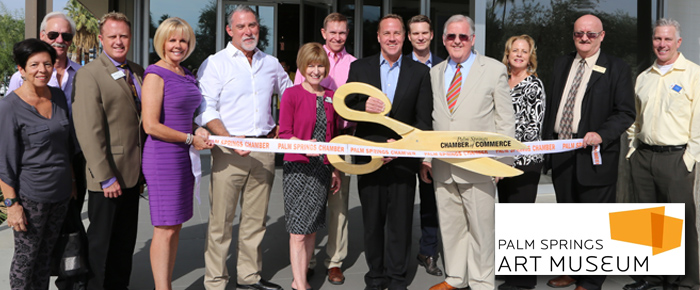
By Kira Golden
On Thursday the 13th of November, Mayor Steve Pougnet, numerous founders, and many appreciative desert citizens celebrated the recent opening of the Palm Springs Art Museum’s new Architecture and Design Center, Edwards Harris Pavilion, with a ribbon-cutting ceremony. Fittingly, the building itself—previously a bank entitled Santa Fe Federal Savings & Loan—was designed by E. Stewart Williams, who is the subject of the opening exhibition.
E. Stewart Williams is responsible for many of the mid-20th Century architecture still in existence in Palm Springs and played a key role in the development of what is known as the Desert Modern style of architecture. This style is characterized by lots of glass walls through which one can view and commune with the beauty of the desert. Williams got his start in 1946 when he was commissioned to build a desert residence for none other than Frank Sinatra. Williams denied Sinatra’s request to build a great big Georgian-style monstrosity and instead drew up the plans for the iconic, sprawling, flat-topped, glass-filled resort home that can still be seen to this day. Williams is noted for stating that, “The architect’s primary job is to transform human needs into functional and habitable space, capturing, if possible, the pulse of human life and human spirit in concrete form.”
Williams is also responsible for the design of the original Palm Springs Art Museum building. That he designed the Art Museum is appropriate given that he studied art as well as architecture at Cornell University. Some of his sketches and etchings are on display at his exhibit, entitled An Eloquent Modernist: E. Stewart Williams, Architect. In addition, there are scale models of his works—including the Sinatra house, original drawings and renderings of his designs, photographs, and even film clips, all of which provide a comprehensive overview of his early life and 50-year career.
While the first floor contains exhibits dedicated to architects and architecture, as well as a museum store located in the former bank vault, the lower levels contain a study center, architectural archives, and meeting space. “We want to ensure that our growing collection is accessible to architects, scholars, and the general public, and that we have the opportunity to develop more programming focused on architecture and design, including current innovations in these fields,” said Sidney Williams, who is the museum’s curator of architecture and design. “The new A+D Center provides us with the much needed space for our permanent collection and temporary exhibitions, and the E. Stewart Williams-designed building itself is an important addition to our collection.”
The former bank, designed in 1961, has been restored by the preeminent Los Angeles architecture firm Marmol Radziner, which used black and white photographs taken by Julius Shulman—who photographed many of Williams’ finished projects—as well as Williams’ original drawings. Since being purchased by the museum in 2011, the building has been awarded Class 1 Historic Site protective status, which will ensure that the integrity of Williams’ design will endure.
The Mayor of Palm Springs himself was given the honor of cutting the ribbon on the afternoon of the 13th. “This is an economic driver for the city,” Pougnet said. “This whole part of town is experiencing a rebirth, and this will be a destination for people to come to.” He emphasized the importance of the cooperation of the entire City Council on this project and how it was unanimously agreed that the spending for the Architecture and Design Center would create greater returns both economically and culturally. Considering that the newly appointed managing director of the Center, former chair of the museum’s Architecture and Design Council J.R. Roberts, was able to recruit about 127 donors to raise $7.4 million, it is clear that the Mayor is not alone in his belief in the importance of this project.
The Mayor also expressed his desire to continue the development and renovation of the areas adjacent to downtown Palm Springs. “This area should be more residential, more urban, and that will be the next stage of our downtown. Having this building here makes it easier to look at the next space and say, ‘Okay, what are we going to do here?”
The E. Stewart Williams exhibit will run from now until February 22, 2015. Following it will be an exhibit entitled Eye on Design: Andrea Zittel’s Aggregated Stacks and the Collection of the Palm Springs Art Museum, which will open on March 14, 2015.









































